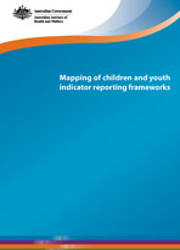Infants, children and young people make up about a third of the Australian population, and have particular health and social needs that require access to a range of services. What happens in the early years provides the foundation for future health, development and wellbeing of the individual, and also shapes the future health and productivity of the whole population.
In recent years, there has been an increase in the number of indicators and reporting frameworks that report on the health and wellbeing of children and young people, in Australia and internationally. This rich reporting environment reflects growing recognition of the importance of reporting on a wide range of indicators to inform policy development (Ben-Arieh 2008; Brown & Anderson 2009).
This report provides an overview of the purpose, scope and reporting status of 6 national frameworks, 4 National Agreements and 5 National Partnership Agreements (the Agreements) that are relevant to children and/or youth. Indicators from the frameworks and Agreements are mapped across 6 broad domains. In doing so, critical topic areas and underlying indicators of shared relevance across frameworks and Agreements, and those that are unique to a particular
framework or Agreement, are identified.
The findings show that in the children's reporting environment, while frameworks and Agreements have some common topics, a large number of indicators are unique to a specific framework or Agreement. Of the child-specific frameworks and Agreements, the Key Child National Indicators is the most comprehensive. About half of its indicators are not reported in the remaining frameworks or Agreements. In the youth environment, there are few youth-specific frameworks, with minimal overlap, and no Australian Government report that comprehensively covers this age group. This is currently an information gap.
The report concludes with recommendations on how reporting on children and youth in Australia could be streamlined and made more timely by drawing on existing web-based data infrastructure, while maintaining the necessary comprehensive coverage. It highlights the importance of co-ordination between the different policy areas responsible for the indicators within the frameworks and Agreements to agree on priorities and ensure a sustainable approach to data development, data collection and reporting.



